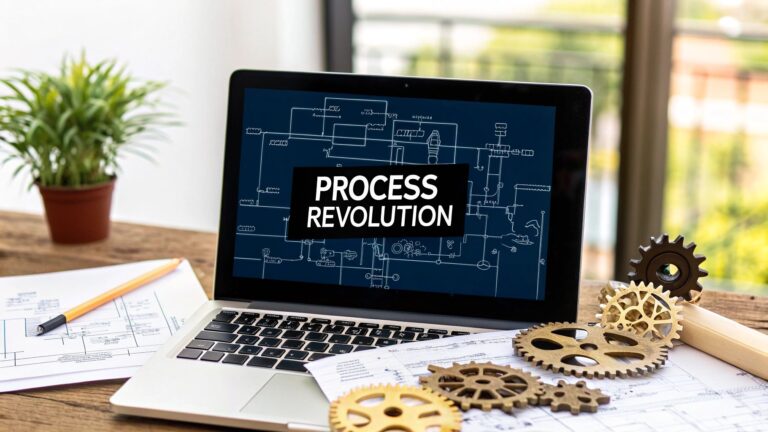Essential How-to Guide For Effective AI Workflow Automation
Automation is revolutionizing the way you handle your tasks and processes. By implementing effective AI workflow automation, you can significantly enhance productivity while minimizing human error. This guide will provide you with the vital steps to streamline your operations and leverage AI benefits efficiently, ensuring your team focuses on what truly matters. Discover how to integrate AI into your workflows and unleash the full potential of your business in the digital age.
Key Takeaways:
- Understand the specific tasks to automate before implementing AI solutions. This helps in identifying the right tools and frameworks.
- Integrate AI with existing workflows to enhance efficiency rather than replacing current systems outright.
- Monitor the performance of AI-driven automation regularly to ensure desired outcomes and adjust strategies accordingly.
- Prioritize data quality and governance since the effectiveness of AI workflows heavily relies on accurate and clean data.
- Engage stakeholders across departments for comprehensive input, which leads to better alignment and acceptance of AI initiatives.

Understanding AI Workflow Automation
AI Workflow Automation enables you to streamline processes by integrating artificial intelligence into your operational workflows. This technology allows tasks to be completed with minimal human intervention, enhancing efficiency and productivity. By leveraging data and advanced algorithms, you can automate repetitive tasks, making your workflow smarter and more adaptable.
What is AI Workflow Automation?
What you need to know is that AI Workflow Automation involves using AI technologies to perform and optimize processes within your organization. This can involve automating routine tasks, managing complex workflows, and providing insights that help you make informed decisions, all aimed at improving overall effectiveness and agility.
Importance and Benefits
Little do many realize, but AI Workflow Automation offers significant advantages for your operations. It enhances efficiency, reduces errors, and enables quicker decision-making, putting you ahead in your industry.
With AI Workflow Automation, you can experience increased productivity as mundane tasks are automated, freeing up your time for higher-value work. This technology also leads to fewer human errors, improving the quality of output. Moreover, by effectively analyzing data, AI provides valuable insights that help in making strategic decisions. Additionally, the scalability of AI systems allows your workflows to adapt to changing demands swiftly, ensuring you remain competitive in a rapidly evolving market.
How to Identify Automation Opportunities
It is crucial to recognize which processes in your organization can benefit from automation. By using tools and approaches that enhance AI Workflow Automation and Orchestration, you can streamline workflows and enhance productivity effectively.
Tips for Recognizing Processes to Automate
Little observations can lead you to significant automation opportunities. Look for processes that follow these characteristics:
- Repetitive tasks
- High volume activities
- Prone to error
- Time-consuming processes
Perceiving these elements can help you pinpoint where automation will provide the most benefit.
Factors to Consider for Effective Automation
On your journey toward successful automation, consider these factors to ensure your efforts yield the desired impact:
- Employee engagement
- Cost-effectiveness
- Integration capabilities
- Scalability
Knowing these aspects will guide you in making informed decisions regarding your automation strategy.
The factors you take into account can significantly influence your automation’s success. For instance, enhancing employee engagement helps create a culture that embraces automation, while assessing cost-effectiveness ensures resources are utilized properly. Additionally, exploring integration capabilities guarantees your solutions can work harmoniously with existing systems. Lastly, focusing on scalability means your automations can grow alongside your business. Knowing these details can significantly enhance your automation journey.
How to Design an Effective AI Workflow
Unlike traditional methods, designing an effective AI workflow requires a strategic approach tailored to your organizational goals. You must identify processes that can benefit from automation, assess data quality, and align AI capabilities with business needs. By following a systematic framework, you will maximize efficiency and enhance productivity, allowing your team to focus on more complex tasks while AI handles repetitive ones.
Steps for Structuring Your Workflow
With a clear understanding of your goals, start by mapping out your existing processes. Identify bottlenecks and areas for improvement, then break down each task into actionable steps. Prioritize these tasks based on their impact and feasibility, integrating AI tools that best fit your objectives. Finally, establish metrics to measure success and iterate on your workflow as necessary.
Common Pitfalls to Avoid
Any misalignment between your AI tools and business goals can hinder your workflow effectiveness. It’s necessary to continually evaluate your processes and ensure that your AI solutions are not just implemented, but integrated smoothly into your existing systems.
Another significant challenge arises from underestimating the importance of data quality. Without accurate and relevant information, your AI algorithms may produce unreliable results. Additionally, neglecting user training can lead to resistance from your team, undermining the potential benefits of automation. Prioritize ongoing evaluation and feedback to identify areas of improvement, ensuring that your workflow remains agile and responsive to changing needs.

How to Select the Right AI Tools
After identifying your requirements, the next step is to select the right AI tools that align with your goals. The market is flooded with options, making it important to evaluate tools based on features, scalability, and user support. Be prepared to invest time in research, including reading user reviews and case studies, to find the best fit that not only meets your current needs but also grows with your organization.
Evaluating AI Tools for Your Needs
Evaluating AI tools begins with a clear understanding of your specific objectives. Assess the functionalities that fit your workflow, focusing on automation capabilities, cost-efficiency, and ease of use. It’s advisable to take advantage of free trials and demos to get hands-on experience with the tools before making a commitment.
Tips for Integration with Existing Systems
Any successful integration requires careful planning and consideration. Here are some important tips to ensure a smooth transition:
- Compatibility: Check if the AI tools can integrate seamlessly with your current software and hardware.
- Data Migration: Plan how to transfer your existing data to the new system without loss.
- User Training: Provide adequate training for your team to maximize the benefits of the new technology.
After these considerations, ensuring the tools fit into your existing ecosystem will empower you to leverage AI more effectively.
A structured approach to integration can lead to a more productive workflow. Prioritize the following elements to enhance your integration process:
- API Availability: Use tools that offer robust API access to facilitate easy communication between systems.
- Scalability: Choose AI solutions that can grow with your organization, allowing for future expansion.
- Support Services: Ensure you have access to reliable technical support to resolve issues quickly.
After implementing these tips, you can significantly enhance your AI tools’ effectiveness while minimizing potential disruptions.
How to Implement AI Workflow Automation
Keep in mind that implementing AI workflow automation starts with assessing your current processes and identifying areas that can benefit from automation. You should explore A guide to inserting AI into your workflow to understand the various tools and technologies available. This knowledge will empower you to make informed decisions to streamline operations and enhance productivity.
Best Practices for Successful Implementation
Automation success hinges on clear objectives and understanding your organization’s needs. Establish metrics to measure performance, and ensure that integration is done incrementally. Regularly review and refine the AI implementation to address emerging challenges and user feedback.
Streamline Your Business with Cutting-Edge Automation
Empower your business with powerful automation tools designed to enhance workflows, improve efficiency, and drive online impact.
Book a CallTraining and Supporting Your Team
Implementation of AI solutions requires you to prioritize ongoing training and support for your team members. This investment will help them adapt to the new technology and maximize its benefits.
Another key aspect is to create an inclusive environment where team members can share their concerns and suggestions. Providing strong resources and workshops will upskill your workforce, empowering them to embrace AI confidently. Ensure that open communication is established throughout the implementation process, as it fosters a culture of adaptability and promotes overall success in adopting new technologies.
How to Measure Success
Not all AI workflow automation is created equal; measuring its success is necessary to ensure you’re gaining the desired outcomes. By assessing automated processes, you can identify what’s working well and what areas need adjustment. This understanding empowers you to refine your approach and maximize the benefits of automation.
Key Metrics for Assessing Workflow Performance
One of the most effective ways to gauge your workflow performance is by utilizing strong metrics. Focus on indicators like time saved, error rates, task completion rates, and employee satisfaction. These metrics can provide significant insights into the efficiency and effectiveness of your automated workflows.
Tips for Continuous Improvement
To foster ongoing success in your AI workflow automation, regularly seek opportunities for continuous improvement. You might consider implementing the following strategies:
- Conduct routine reviews of workflow processes
- Encourage team feedback on automation tools
- Hold training sessions to enhance user proficiency
- Evaluate new technologies regularly
This cyclical approach will keep your workflows dynamic and responsive to change.
Plus, it’s important to create an environment that welcomes innovation and improvements. Fostering open communication among team members can lead to more efficient practices and reduce the risk of stagnation. Staying up-to-date with the latest AI trends and technologies can also present new opportunities for optimization.
- Allocate time for brainstorming sessions
- Recognize and reward team contributions
- Analyze industry benchmarks for performance comparison
- Document lessons learned throughout the process
This approach enables you to maintain a proactive stance in evolving your AI workflows.
Summing up
To wrap up, implementing effective AI workflow automation is a transformative step for your business. By understanding the key components and phases of the process, you can streamline operations and enhance productivity. Start by assessing your current workflows, identifying automation opportunities, and selecting the right tools to fit your needs. As you integrate AI into your processes, remains flexible and continuously evaluate performance to ensure optimal efficiency. With these strategies in place, you’re well on your way to achieving a seamless AI-driven workflow that propels your success.
Q: What are the initial steps to take when implementing AI workflow automation in my business?
A: To kick off AI workflow automation, start by clearly defining your business objectives. Identify repetitive tasks that could benefit from automation, such as data entry or customer support. Next, assess the tools available that best suit your needs—these can range from AI-powered software to custom solutions. Finally, ensure you have a current data set to train your models effectively, as quality data is key to achieving successful automation.
Q: How can I measure the effectiveness of an AI workflow automation system?
A: Measuring the effectiveness of AI workflow automation involves tracking several key performance indicators (KPIs). These may include efficiency metrics like time saved on tasks, error rates before and after automation, and customer satisfaction scores. Conducting regular reviews of automated workflows will also help you identify any bottlenecks or areas for improvement, ensuring that your AI tools are delivering the intended benefits.
Q: What challenges might I face when integrating AI into existing workflows, and how can I overcome them?
A: Integrating AI into existing workflows can present challenges such as resistance to change, data integration issues, and the learning curve associated with new technologies. To overcome these obstacles, engage your team early on in the process to foster buy-in, provide training and support, and ensure that your AI solutions are compatible with current systems. Additionally, starting with pilot programs can help you iron out any issues before full-scale implementation.







